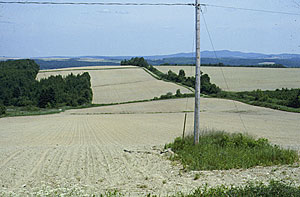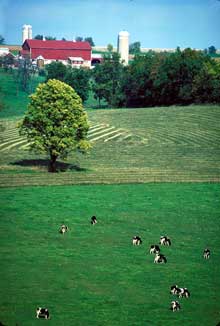PATCHES
Habitat patches are easy to pick out in the landscape. Quite simply, they are any clump of natural habitat which is different from
its surroundings. A flowerbed surrounded by a lawn, a pond surrounded by cropland, a stand of trees surrounded by a meadow--these
are all patches we see everyday. Key to understanding patches are the words homogenous and heterogenous . Patches are relatively homogenous environments which differ from their surroundings (Foreman 1995). Though the patches in themselves are homogenous, it is vital to consider how these patches relate to the heterogenous nature of their surroundings.

Can you pick out the patch in this picture? Do you see any others?
Source: D. Patriquin
It is also good to be aware of the different ways in which a homogenous patch different from its surroundings can be created. According to Foreman (1995), patches can be created from the following:
- a disturbance (either human-induced or natural) which fragments the natural habitat. Deforestation and land-clearing are examples of human-induced disturbance whereas forest fires, floods or animal behaviour(browsing,burrowing) are natural disturbances (Morrison et. al 1992);
- environmental conditions, such as soil or rock type, which influences the type of vegetation which grows;
- regeneration which occurs when vegetation grows upon previously disturbed sites;
- introduction , when humans create patches through such activities as tree planting or transplanting.
Patch characteristics
Patches have a variety of characteristics. Two of the most important to consider are the following:- Patches come in different shapes and sizes. They may be small or large, narrow, wide, circular or elongated. The shape and size of a patch affects wildlife as well as ecological processes such as nutrient and water flow, soil processes, wind flow, and so on.
- Patches can change over time. For instance, a patch of grassy habitat may be full of green foliage and blooming flowers in the summer, but barren in the winter (Kozakiewicz 1995).

What might be patches in this picture? Source: Ron Nichols, the USDA photo center
Ponds, woodlots and beetle banks are three important habitat patches often found upon farms. Piles of straw, stone heaps, chopped wood and piles of branches can also provide useful breeding areas for birds and reptiles(van Mansvelt & van der Lubbe 1999).
POND A mixture of permanent and temporary ponds can provide a variety of habitat for invertebrates such as snails, beetles, and flies. It is generally more helpful for species if these ponds are clustered for this facilitates easier movement from pond to pond (van Mansvelt & van der Lubbe 1999). |
WOODLOTS Woodlots can be the most stable element upon a farm, providing an important habitat for many species such as forest-dwelling birds, plants and insects (Petit & Usher 1998). |
BEETLE BANKS Beetle banks are strips of permanent grassy habitat planted within arable cropland. They serve as a habitat for predatory invertebrates such as beetles and spiders. Other wildlife may use these banks for foraging and shelter purposes as well (The European Conservation Institutes Research Network). |
 The leaf beetle,diorhabda elongata, a beneficial insect. Photo by: Bob Richard, U.S Agricultural Research Image Gallery. |
Home Page